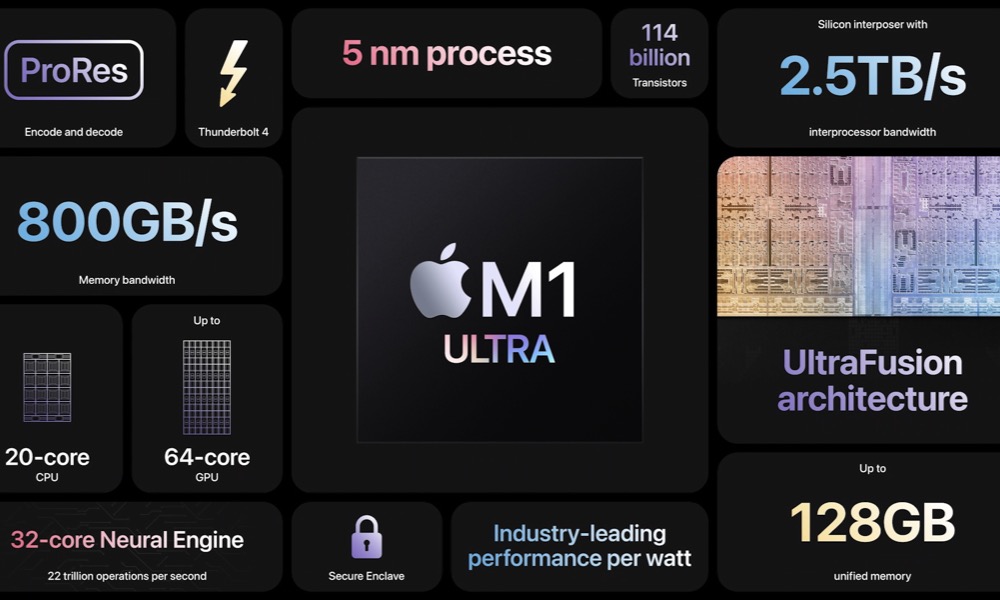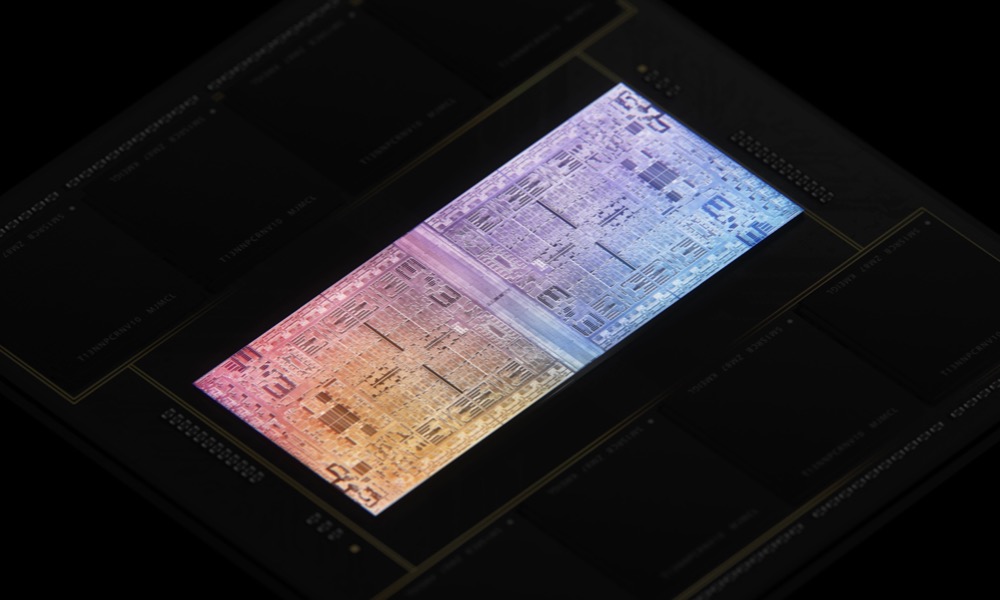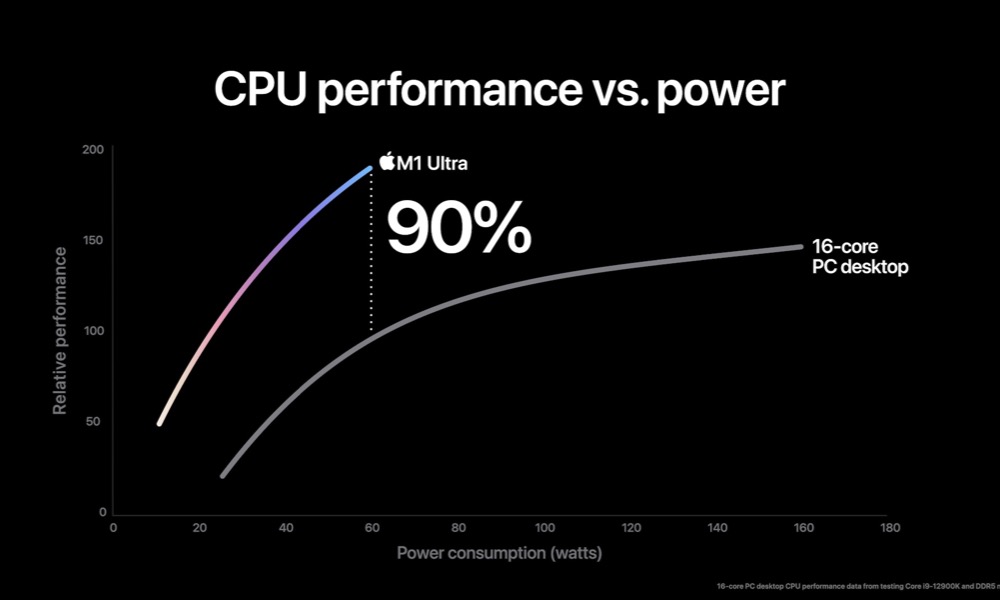Apple Unveils Even More Insanely Powerful ‘M1 Ultra’ Chip That Beats Everything in the Industry
 Credit: Apple
Credit: AppleToggle Dark Mode
Just when you thought Apple couldn’t push its silicon any further, the company surprised us today with the debut of an even more insanely powerful M1 Ultra — the first Apple Silicon chip that pushes performance even beyond its highest-end Mac Pro.
John Ternus, Apple’s Senior VP of Hardware Engineering, took the stage to announce this “next giant leap” for Apple Silicon, and unveil the name of the new chip as the M1 Ultra, before handing things over to his counterpart on the Hardware Technologies side, Johny Srouji.
Today, we’re bringing Apple Silicon to users who need even more extreme levels of performance. We’re adding one last chip to the M1 family, and it’s going to blow your mind…John Ternus, SVP, Hardware Engineering
The new M1 Ultra represents the melding of an interesting assortment of rumours we’ve heard over the past few months. As far back as December, hardware enthusiasts discovered that the M1 Max chip was designed to be “stacked”, with a die-to-die interconnect, suggesting that Apple had already paved the way for what would become an even more powerful M1 Max chip combo.
Several names were bandied about for this new stacked powerhouse, including M1 Max Duo and M1 Max Quadra, which would combine two and four M1 Max chips, respectively.
Another suggestion was M1 Max Ultra, or even simply M1 Ultra, but the lines on that one got blurred when another rumour appeared in late January suggesting that Apple was planning a souped-up 12-core version of the M1 Max that would be earmarked for the new iMac Pro.
That’s not what the M1 Ultra turned out to be, however, and today’s Peek Performance event earned its name with the debut of what is effectively an “M1 Max Duo” — a pair of M1 Max chips joined at the hip to create a powerful 20-core CPU and 64-core GPU combo with 128GB of unified memory.
This is something that’s never been done before, at least not quite in this way.
The concept of stacking custom chip designs isn’t entirely new, but it’s also traditionally been reserved for custom designs aimed at large data center applications.
Apple’s M1 Ultra also shattered the record for the number of transistors on a single chip, since it effectively doubles the M1 Max, breaking the 100-billion transistor barrier with 114 billion in total — seven times the number of transistors found on the standard M1, and three times that of the M1 Pro.
Breakthrough Performance
The real magic behind the M1 Ultra isn’t just the fact that Apple has put two M1 Max chips together, since like we said, that’s not really a novel idea. However, Apple architected the M1 Max in such a way that this could be done to create a truly unified chip, where both sides can communicate with each other so quickly that they’re acting as one chip.
Traditionally, architecture used to stack chips most commonly involves connecting them via the motherboard, which results in increased latency and much higher power consumption. Plus, it’s still two chips, so only apps that are coded for the multiple CPUs can actually take advantage of the extra power.
That’s not what Apple has done. Instead, it’s created a custom-built packaging architecture that drives the I/O between the two chips at full speed, and allows them to share everything from processing power to the unified memory architecture. As Srouji says, it’s “way ahead of anything else in the industry.”
Apple calls this technique “Ultra Fusion Architecture,” and the performance it delivers is nothing short of astounding. The bandwidth between the two M1 Max halves of the M1 Ultra is 2.5 terabytes per second, which works out to more than four times the bandwidth of the leading interconnect modular technology used by rivals like Intel and other custom silicon shops.
This also means that software sees the M1 Ultra as a single chip. No special coding or upgrades are required — any app that supports the M1 will automatically benefit from the power of the M1 Ultra.
Srouji outlines the specs of the M1 Ultra as follows:
- 20-core CPU Compute Engine, with 16 High-Performance Cores and 4 High-Efficiency Cores.
- 64-core GPU Graphics Engine, running at 21 teraflops.
- 32-core Neural Engine, capable of 22 trillion operations per second.
- Eight Times Faster than the M1 at general computing tasks.
- An enhanced Media Engine with two video decoders, four video encoders, and four ProRes encoders.
- 65% lower power consumption than the leading 10-core PC desktop chop.
- 90% higher performance in the same power envelope compared to the fastest 16-core PC desktop.
- It can deliver the same peak performance as the leading PC desktop chip while using 100W less power.
- It can provide similar performance to one of the most popular discrete GPUs on the market while consuming 1/3 of the power.
- It can outperform the highest-end GPU at 200W less power consumption.
- The 128GB of unified memory operates at 800GB/s, and is fully available to the GPU Graphics Engine, offering more graphics memory than anything else on the planet.
While there’s also the possibility that Apple could stack four M1 Max chips (or two M1 Ultra chips) to produce something even more powerful, this would be a slightly more complicated affair, as Apple would likely need to engineer an additional I/O die to sit between the two M1 Ultra chips.
While it’s possible Apple is still considering that, it’s also fair to say that the M1 Ultra is already more than enough for this generation of Apple Silicon. We’ll probably move into the M2 series later this year, at which point Apple will almost certainly be working on even more ways of pushing performance to levels that we’ve never imagined.
An Open Secret
While Srouji described the die-to-die interconnect technology as “a secret, hidden feature” of the M1 Max, it was something that had already slipped out to those who were watching closely. Apple may not have brought it up, but all the signposts were that this was most likely the road to the new Mac Pro — or something like it.
That “something” turned out to be the Mac Studio, which came in a surprising announcement today as the first Mac to feature the new M1 Ultra chip. It may not quite be the Mac Pro, but it’s enough to leave Apple’s flagship professional Mac in the dust — and in an enclosure that has the same footprint as the Mac mini.
There will likely still be another Mac Pro that moves to Apple Silicon down the road, but for now, Apple is also deliberately taking its time. Multi-million dollar studios don’t turn on a dime when it comes to adopting new technology, so they’re likely to stay with the tried-and-true Intel Xeon technology until Apple Silicon has fully proven itself. The M1 Ultra and Mac Studio are a big step in that direction.










